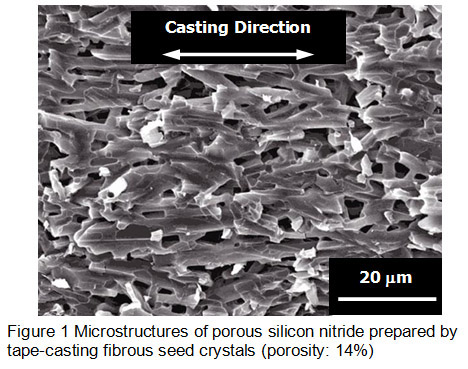Microstructural Design of Porous Ceramics for Unique Mechanical Properties
Prof. Tatsuki Ohji
Pores have been generally believed to deteriorate mechanical reliability. However, the presence of pores does not always lead to degradation, but on the contrary, can give rise to improved or unique performance whenever the porous microstructure is carefully controlled. For example, porous silicon nitrides where characteristic fibrous grains display a high degree of directionality (Fig. 1), exhibit high fracture energy as well as high fracture strength. The material of 14% porosity has fracture strength in excess of 1 GPa, when a stress is applied in the alignment direction. The fracture energy obtained by a chevron-notched beam technique was about 500 J/m2, which is 7 times larger than that of dense silicon nitride (Fig. 2). High fracture toughness above 17 MPa m1/2 as well as high strength above 1.5 GPa are attained in the porosity range below 5%. These excellent mechanical properties are primarily attributable to grain "pull-out" enhanced by the existence of pores around the aligned fibrous grains. Microstructure observations showed that the pores enhanced debonding between the interlocking fibrous grains, leading to marked increases in pulled-outs fibrous grains during crack propagation. It has been also revealed that these porous silicon nitrides exhibit much superior thermal-shock resistances even to the dense materials, for both the fracture and damage resistances (so called R and R”” respectively) which are known to be in antagonistic relation.


CV-Ohji.pdf



